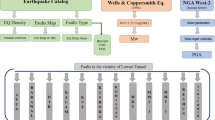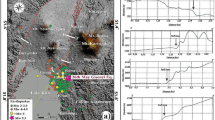Abstract
This study presents a first-level spatial assessment of the susceptibility to earthquake-induced landslides in the seismic area of the Agri Valley (Basilicata Region, southern Italy), which hosts the largest onshore oilfield and oil/gas extraction and pre-treatment plant in Europe and is the starting point of the 136-km-long pipeline that transports the plant’s products to the refinery located in Taranto, on the Ionian seacoast. Two methodologies derived from the ones proposed by Newmark (Geotechnique 15(2):139–159, 1965) and Rapolla et al. (Eng Geol 114:10–25, 2010, Nat Hazards 61:115–126, 2012. doi:10.1007/s11069-011-9790-z), based on different modelling approaches, were implemented using the available geographic information system tools, which allowed a very effective exploitation of the two models capability for regional zoning of the earthquake-induced landslide hazard. Subsequently, the results obtained from the two models were compared by both visual evaluation of thematic products and statistical correlation analysis of quantitative indices, such as the Safety Index based on the Newmark’s approach and the Susceptibility Index from Rapolla’s model. The comparison showed a general agreement in highlighting the most critical areas. However, some slight differences between the two models’ results were observed, especially where rock materials and steep slopes are prevailing.






Similar content being viewed by others
References
Altman DG (1999) Practical statistics for medical research. Chapman & Hall/CRC Press, New York
Ambraseys N (1975) The correlation of intensity with ground motion. In: Proceedings of the XIV General Assembly of the European Seismological Commission, Trieste, 16–22 September 1974, pp 335–341
Ambraseys N, Srbulov M (1995) Earthquake-induced displacements of slopes. Soil Dyn Earthq Eng 14:59–71. doi:10.1016/0267-7261(94)00020-H
Benedetti L, Tapponier P, King GCP, Piccardi L (1998) Surface rupture of the 1857 southern Italian earthquake? Terra Nova 10:206–210. doi:10.1046/j.1365-3121.1998.00189.x
Boccardo P (2013) New perspectives in emergency mapping. Eur J Remote Sens 46:571–582. doi:10.5721/EuJRS20134633
Borfecchia F, De Cecco L, La Porta L, Lugari A, Martini S, Pollino M, Ristoratore E, Pascale C (2010) Active and passive remote sensing for supporting the evaluation of the urban seismic vulnerability. Ital J Remote Sens 42:129–141. doi:10.5721/ItJRS201042310
Borraccini F, De Donatis M, Di Bucci D, Mazzoli S (2002) 3D model of the active extensional fault system of the high Agri River Valley, Southern Apennines, Italy. J. Virtual Explor. 6:1–8
Caputo R, Fiore A, Piedilato S, Sessa R (2004) Analisi dell’amplificazione sismica locale ai fini della pianificazione urbanistica. Caso di studio di Ginestra (PZ) nell’Appennino Meridionale. Geologia tecnica e ambientale 1:57–66
Caputo R, Fiore A, Sessa R (2006) Parametri geologici e territoriali per la pianificazione urbanistica in area sismica. Caso studio di Ripacandida (PZ) nell’Appennino meridionale. Giornale di Geologia Applicata 4:189–194. doi:10.1474/GGA.2006-04.0-24.0152
Cello G, Tondi E, Micarelli L, Mattioni L (2003) Active tectonics and earthquake sources in the epicentral area of the 1857 Basilicata earthquake (Southern Italy). J Geodyn 36:37–50. doi:10.1016/S0264-3707(03)00037-1
Cherubini C, Vessia G, Mannara G, Pingitore D (2008) Valutazione della risposta sismica locale a Sant’Angelo dei Lombardi: il caso dell’ex tribunale. Giornale di Geologia Applicata 8(2):177–191. doi:10.1474/GGA.2005-02.0-24.0050
Cohen J (1960) A coefficient of agreement for nominal scales. Educ Psychol Meas 20:37–46. doi:10.1177/001316446002000104
Di Giulio G, Improta L, Calderoni G, Rovelli A (2008) A study of the seismic response of the city of Benevento (Southern Italy) through a combined analysis of seismological and geological data. Eng Geol 97:146–170. doi:10.1016/j.enggeo.2007.12.010
Eurocode 8 (2003) EN 1998-1, design of structure for earthquake resistance—Part 1: general rules, seismic actions and rules for buildings. CEN European Committee for Standardization, Bruxelles
Fell R, Corominas J, Bonnard C, Cascini L, Leroi E, Savage WZ (2008) Guidelines for landslide susceptibility, hazard and risk zoning for land use planning. Eng Geol 102:85–98
Giano SI, Maschio L, Alessio M, Ferranti L, Improta L, Schiattarella M (2000) Radiocarbon dating of active faulting in the Agri high valley, Southern Italy. J Geodyn 29:371–386
Giocoli A, Stabile TA, Adurno I, Perrone A, Gallipoli MR, Gueguen E, Norelli E, Piscitelli S (2015) Geological and geophysical characterization of the southeastern side of the High Agri Valley (southern Apennines, Italy). Nat Hazards Earth Syst 15:315–323. doi:10.5194/nhess-15-315-2015
Guemache MA, Machane D, Beldjoudi H, Gharbi S, Djadia L, Benahmed S, Ymmel H (2010) On a damaging earthquake-induced landslide in the Algerian Alps: the March 20, 2006 Laâlam landslide (Babors chain, northeast Algeria), triggered by the Kherrata earthquake (Mw 5 5.3). Nat Hazards 54:273–288. doi:10.1007/s11069-009-9467-z
Hossam AK, Hossam AG (2010) Review of pipeline integrity management practices. Int J Press Vessels Pip 87:373–380. doi:10.1016/j.ijpvp.2010.04.003
Improta L, Ferranti L, de Martini PM, Piscitelli S, Bruno PP, Burrato P, Civico R, Giocoli A, Iorio M, D’addezio G, Maschio L (2010) Detecting young, slow-slipping active faults by geologic and multidisciplinary high-resolution geophysical investigations: a case study from the Apennine seismic belt, Italy. J Geophys Res 115:B11307. doi:10.1029/2010JB000871
ISPRA—Servizio Geologico d’Italia (2006) Progetto IFFI (Inventario dei Fenomeni Franosi in Italia). Landslide Inventory Map of Italy at 1:25,000 scale. ISPRA—Dipartimento Difesa del Suolo-Servizio Geologico d’Italia—Regione Campania (www.sinanet.apat.it/progettoiffi)
Jibson RW (2011) Methods for assessing the stability of slopes during earthquakes—a retrospective. Eng Geol 122:43–50
Jibson RW, Harp EL, Michael JA (2000) A method for producing digital probabilistic seismic landslide hazard maps. Eng Geol 58:271–289. doi:10.1016/S0013-7952(00)00039-9
Kamp U, Owen LA, Growley BJ, Khattak AG (2010) Back analysis of landslide susceptibility zonation mapping for the 2005 Kashmir earthquake: an assessment of the reliability of susceptibility zoning maps. Nat Hazards 54:1–25. doi:10.1007/s11069-009-9451-7
Keefer DK (1984) Landslides caused by earthquakes. Geol Soc Am Bull 95:406–421. doi:10.1130/0016-7606(1984)95<406:LCBE>2.0.CO;2
Kouli M, Loupasakis C, Soupios P, Vallianatos F (2010) Landslide hazard zonation in high risk areas of Rethymno Prefecture, Crete Island, Greece. Nat Hazards 52:599–621. doi:10.1007/s11069-009-9403-2
Mahdavifar M, Memarian P, Manjil R (2012) Assessment of earthquake-induced landslides triggered by earthquake in Rostamabad(Iran) quadrangle using knowledge-based hazard analysis approach. In: Keizo U, Hiroshi Y, Akihiko W (eds) Proceedings of the International Symposium on Earthquake-Induced Landslides, Kiryu, Japan, pp 769–780. ISBN 978-3-642-32238-9
Maschio L, Ferranti L, Burrato P (2005) Active extension in Val d’Agri area, Southern Apennines, Italy: implications for the geometry of the seismogenic belt. Geophys J Int 162:591–609. doi:10.1111/j.1365-246X.2005.02597.x
Maugeri M, Mussumeci G, Biondi G, Condorelli A (2005) Strumenti di analisi e metologie di rappresentazione in un SIT “specializzato” sul rischio sismico di frana. Boll SIFET 1(2005):53–70 (in Italian)
Maugeri M, Motta E, Mussumeci G, Raciti E (2009) Lifeline seismic hazards: a GIS application. WIT Trans Built Environ 104:381–392. doi:10.2495/ERES090351
Ministero dello Sviluppo Economico (2013) Executive summary of DGRME annual report 2013—year 2012. http://unmig.sviluppoeconomico.gov.it/unmig/stat/ra2013eng.pdf
Mora S, Vahrson W (1994) Macrozonation methodology for landslide hazard determination. Bull Int As Eng Geol 31(1):49–58
Mucciarelli M, Caputo V, Sdao F, Gallipoli M.R, Giano S.I, Bianca M, Bulfaro M, Camassi R, Lopiano M, Lizza C, Bruno G (2006) Convenzione tra Regione Basilicata e Di.S.G.G.-Università della Basilicata per la realizzazione del progetto di monitoraggio geofisico e di amplificazione sismica di sito di aree vulnerabili del territorio regionale. Relazione Finale Preliminare 08/10/02-31/07/05. http://www.crisbasilicata.it/microzonazione/documenti/Rapporto_finale_Microzonazione_rev2.pdf (in Italian)
Newmark NM (1965) Effects of earthquakes on dams and embankments. Geotechnique 15(2):139–159
N.T.C (2008) Approvazione delle nuove norme tecniche per le costruzioni (Italian Building Code). Gazzetta Ufficiale della Repubblica Italiana, n. 29 del 4 febbraio 2008—Suppl. Ordinario n. 30, 2008 (in Italian)
Pantosti D, Valensise G (1990) Faulting mechanism and complexity of the November 23, 1980, Campania-Lucania earthquake, inferred from surface observation. J Geophys Res 95:15319–15341
Rapolla A, Paoletti V, Secomandi M (2010) Seismically-induced landslide susceptibility evaluation: application of a new procedure to the island of Ischia, Campania Region, Southern Italy. Eng Geol 114:10–25. doi:10.1016/j.enggeo.2010.03.006
Rapolla A, Di Nocera S, Matano F, Paoletti V, Tarallo D (2012) Susceptibility regional zonation on earthquake-induced landslide in Campania, Southern Italy. Nat Hazards 61:115–126. doi:10.1007/s11069-011-9790-z
Refice A, Capolongo D (2002) Probabilistic modeling of uncertainties in earthquake-induced landslide hazard assessment. Comput Geosci 28(6):735–749
Rodriguez CE, Bommer JJ, Chandler RJ (1999) Earthquake-induced landslides: 1980–1997. Soil Dyn Earthq Eng 18:325–346. doi:10.1016/S0267-7261(99)00012-3
Romeo R (2000) Seismically induced landslide displacements: a predictive model. Eng Geol 58:337–351. doi:10.1016/S0013-7952(00)00042-9
Shebeko YN, Bolodian IA, Molchanov VP, Deshevih YI, Gordienko DM, Smolin IM, Kirillov DS (2007) Fire and explosion risk assessment for large-scale oil export terminal. J Loss Prev Process 20:651–658. doi:10.1016/j.jlp.2007.04.008
Vignola N, Tramutoli M, Melfi D (2001) Analisi del dissesto da frana in Basilicata. Progetto IFFI, Conv. Reg. Basilicata n. DSTN/27 7885. http://www.isprambiente.gov.it/files/pubblicazioni/rapporti/rapporto-frane/capitolo-22-basilicata.pdf (in Italian)
Wasowski J, del Gaudio V, Pierri P, Capolongo D (2002) Factors controlling seismic susceptibility of the Sele Valley slopes: the case of the 1980 Irpinia earthquake re-examined. Surv Geophys 23:563–593. doi:10.1023/A:1021230928587
Wilson RC, Keefer DK (1983) Dynamic analysis of a slope failure from the 6 August 1979 Coyote Lake, California, earthquake. Bull Seismol Soc Am 73:863–887
Yang Z, Lan H, Gao X, Li L, Meng Y, Wu Y (2014) Urgent landslide susceptibility assessment in the 2013 Lushan earthquake-impacted area, Sichuan Province, China. Nat Hazards. doi:10.1007/s11069-014-1441-8
Acknowledgments
Thanks to Todd Hinkley (Scientist Emeritus—US Geological Survey) for his kind review of the manuscript. Thanks to the anonymous reviewers for their useful suggestions to improve the manuscript. This work was developed in the frame of Project “RoMA” (funded by Italian MIUR SCN_00064 Call “Smart Cities and Communities”) and FP7 Network of Excellence CIPRNet, which is being partly funded by the European Commission under Grant Number FP7-312450-CIPRNet.
Author information
Authors and Affiliations
Corresponding author
Rights and permissions
About this article
Cite this article
Borfecchia, F., De Canio, G., De Cecco, L. et al. Mapping the earthquake-induced landslide hazard around the main oil pipeline network of the Agri Valley (Basilicata, southern Italy) by means of two GIS-based modelling approaches. Nat Hazards 81, 759–777 (2016). https://doi.org/10.1007/s11069-015-2104-0
Received:
Accepted:
Published:
Issue Date:
DOI: https://doi.org/10.1007/s11069-015-2104-0






